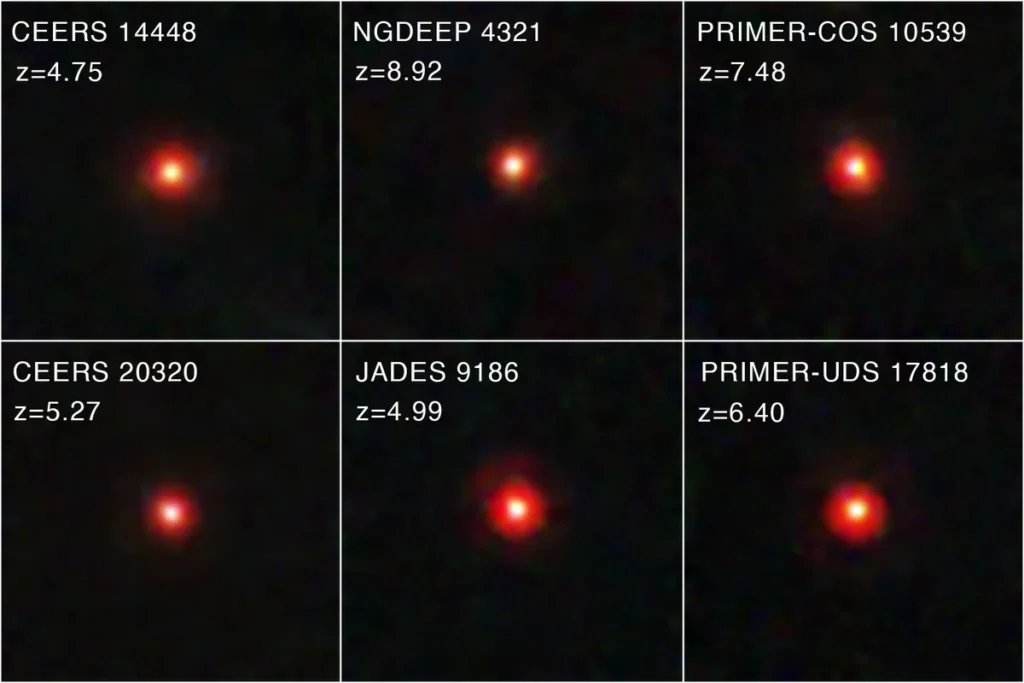Black hole spotted near the Big Bang has astronomers scratching their heads for one key reason

Black hole spotted near the Big Bang has astronomers scratching their heads for one key reason
A supermassive black hole has been discovered that formed when the Universe was just 3% of its current age.
That’s around 500 million years after the Big Bang, or 13.3 billion years ago.
Found in the centre of a galaxy known as CAPERS-LRD-z9, it’s the most distant black hole ever confirmed and a rare glimpse into the cosmic dawn.
Finding the black hole
The black hole was spotted by an international team of astronomers led by the Cosmic Frontier Center at the University of Texas at Austin, using data from the James Webb Space Telescope.
“When looking for black holes, this is about as far back as you can practically go,” says Anthony Taylor, a postdoctoral researcher at the centre.
“We’re really pushing the boundaries of what current technology can detect.”

The team used spectroscopy to split the light from CAPERS-LRD-z9 into its component wavelengths and study the object’s characteristics.
This revealed a broad hydrogen emission line, a telltale sign of gas circling a black hole and falling into the gravity well in its centre.
As the fast-moving gas is pulled into this singularity, the wavelength of its light is stretched to much redder wavelengths.
As Taylor explains, “There aren’t many other things that create this signature. And this galaxy has it!”

Unusually enormous
Not only that, but this black hole is a monster, estimated to be up to 300 million times the mass of our Sun, unusual for such an early epoch.
Its host galaxy CAPERS-LRD-z9 belongs to a newly identifed class of galaxies know as little red dots, which are very compact, red and unexpectedly bright.
These seem to have only been present in the first 1.5 billion years of the Universe and are unlike anything ever seen before.
“The discovery of little red dots was a major surprise from early JWST data, as they looked nothing like galaxies seen with the Hubble Space Telescope,” explains Steven Finkelstein, a co-author on the study.
“Now, we’re in the process of figuring out what they’re like and how they came to be.”
The team hopes to gather higher-resolution JWST observations.
“This is a good test object for us,” says Taylor. “We haven’t been able to study early black hole evolution until recently, and we’re excited to see what we can learn from this unique object.”
This news story appeared in the October 2025 issue of BBC Sky at Night Magazine
Scientists using the James Webb Space Telescope (JWST) have identified the earliest black hole found thus far, dating back to more than 13 billion years ago.
The black hole and its home galaxy, together dubbed CAPERS-LRD-z9, existed just 500 million years after the Big Bang. Its properties could help researchers understand what the universe was like in that elusive early era, according to a study published August 6 in the Astrophysical Journal Letters.
Black hole :“When looking for black holes, this is about as far back as you can practically go,” study coauthor Anthony Taylor, an astronomer at the University of Texas, Austin, said in a statement. “We’re really pushing the boundaries of what current technology can detect.”
CAPERS-LRD-z9 is a type of galaxy called a “Little Red Dot,” so named because they’re small (as galaxies go) and appear to emit red light when observed with JWST’s powerful infrared sensors. Little Red Dots shine brightly, which might suggest they contain a lot of stars — except they formed in the early universe, when an abundance of stars was unlikely, according to current leading theories of cosmology.

“The discovery of Little Red Dots was a major surprise from early JWST data, as they looked nothing like galaxies seen with the Hubble Space Telescope,” study coauthor Steven Finkelstein, an astronomer at UT Austin, said in the statement. “Now, we’re in the process of figuring out what they’re like and how they came to be.”
To better understand the nature of CAPERS-LRD-z9 and Little Red Dots like it, researchers investigated the galaxy with the JWST. The team found a distinct pattern of wavelengths of light created when fast-moving gas falls into a black hole. Though astronomers have found a few objects farther away than CAPERS-LRD-z9 that might be black holes, this pattern makes CAPERS-LRD-z9 the earliest confirmed black hole to date and suggests that black holes might lie at the center of other Little Red Dots.
The black hole at the center of CAPERS-LRD-z9 is pretty hefty. It’s some 38 million times more massive than the sun or about 10 times more massive than Sagittarius A*, the supermassive black hole at the center of the Milky Way — though there’s considerable wiggle room in that estimate. The scientists also think that the black hole has as much mass as about 5% of all the stars in its galaxy put together, a ratio far exceeding that of modern galaxies.
“This adds to growing evidence that early black holes grew much faster than we thought possible,” Finkelstein said. “Or they started out far more massive than our models predict.”
CAPERS-LRD-z9 could also help explain why Little Red Dots are red. A dense cloud of gas surrounding the black hole could shift any emitted light into longer, redder wavelengths, the researchers predicted.
Further studies of CAPERS-LRD-z9 could offer even more information about black holes and galaxies in the early universe, the scientists wrote in the study.
Read Also: Keep your face towards the sunshine and shadows will fall behind you
“This is a good test object for us,” Taylor said in the statement. “We haven’t been able to study early black hole evolution until recently, and we are excited to see what we can learn from this unique object.”
The key puzzling issue is how such a massive black hole could already exist so early on in cosmic history. In short:
Mass growth time
The theoretical models for black hole formation (e.g. from collapsing stars, then gradual accretion and mergers) don’t easily allow a black hole to grow to hundreds of millions of solar masses in just a few hundred million years. It strains the time available under conventional growth rates.
Seed mass problem
To get there, the “seed” black hole would need to start off much larger (a “heavy seed”) rather than the modest seeds one expects from stellar remnants. This raises questions about what mechanisms or conditions could produce such heavy seeds in the early universe.
Black hole–galaxy mass ratio
In modern galaxies, black holes are typically a tiny fraction of their host galaxy’s mass. But here, the black hole seems to be proportionally very large compared to what’s observable in its galaxy. That suggests a different growth or formation history than what local galaxies show.
Live Science
Sky at Night Magazine
Lack of heavy elements / pristine environment
The environment around such early objects is expected to be more “pristine” (mostly hydrogen and helium, fewer heavy elements), making the physical conditions for black hole formation and growth more constrained. If a black hole is too massive too early in that environment, it challenges what we think possible.
The Guardian
“Naked” black holes / reversed order
In some related discoveries (e.g. QSO1, a high-redshift, gravitationally lensed active galactic nucleus), the black hole might have formed before its host galaxy — that’s contrary to the usual paradigm where galaxies collapse first and then central black holes grow.
Watch Also:https://www.youtube.com/@TravelsofTheWorld24






Leave a Reply